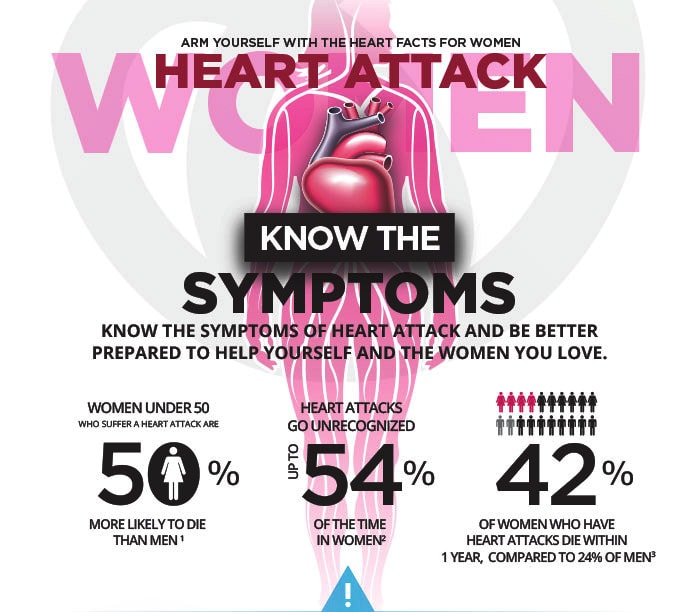 Heart disease is an equal-opportunity condition: It can affect anyone at any age, from newborns to the very old.
Heart disease is an equal-opportunity condition: It can affect anyone at any age, from newborns to the very old.
There was a time when most people assumed that heart disease occurred primarily in older adults, and to a great extent that is still true.
HOWEVER, because of the increasing prevalence of risk factors for heart disease among younger people, including obesity, type 2 diabetes, high cholesterol and high blood pressure, we are seeing cases of heart disease develop in younger individuals.
Read: 17 Common Types of Heart Disease
Although heart disease is the number one killer of both men and women, and there are many similarities between the sexes when it comes to heart disease, there are also some important differences.
We talk about some of those differences, for example. where we point out the signs and symptoms of heart disease, which can differ between men and women.
Knowing those differences could save your life or that of a loved one someday.
Women and heart disease
Here we want to mention that women tend to experience heart disease ten years later than men, which is believed to be associated with the heart-protective effect of estrogen, and that they also tend to have a worse prognosis once they enter the hospital, which may be related to the fact that they tend to be older and/or have a more severe case by the time they are hospitalized.

More women than men die of heart disease each year, and women are six times as likely to die of heart disease as of breast cancer.
Heart disease kills more women older than 65 than do all types of cancer.
Men possess a higher risk for coronary artery disease along with cardiac arrest earlier in their lives compared to women.
Whilst women’s risk to have coronary heart disease raises once menopause.
Heart attack symptoms and early warning signs
Women could possibly have symptoms which they overlook for ages prior to experiencing a heart attack.
Some doctors however don’t identify the signs claimed by female patients.

Image source: cwhhc.ottawaheart.ca
Men usually experience the “classic” coronary heart attack symptoms : shortness of breath, chest tightness as well as arm pain.
Women’s signs may look like the ones from men.
Nevertheless, a woman may complain of other signs, which include nausea, tiredness, heartburn, stress and anxiety, along with giddiness.
Manage the risk factors for heart disease
Women ought to talk with their medical professional to cope with risk factors that they’re able to change.
- Apply lifestyle guidelines to maintain your levels of cholesterol within the ideal range. Goals for blood cholesterol levels differ based on your own risk factors. Consult your doctor which goals are ideal for you.
- Always maintain your blood pressure level within a healthy range. The suitable blood pressure level depending on individual risk factors. Set your target blood pressure after discussing with medical professional.
Estrogen is no longer utilized to protect against coronary heart disease in women of all ages.
Estrogen could raise the probability of cardiovascular disease in elderly women.
Nevertheless, it might be utilized in quite a few women to relieve menopausal flashes or any other health concerns.
- Estrogen usage is likely most secure for women beneath sixty years old.
- Estrogen has to be consumed for the least possible length of time.
- Estrogen should only be consumed by women who possess a low risk for coronary heart disease, stroke, blood clots or even breast cancer.
For women with higher risk for heart disease, daily aspirin intake is known to prevent cardiac arrest.
Considering that aspirin may raise the possibility for bleeding, your doctor need to look at if the benefits outnumber the potential risks in your circumstance.
Change to heart-healthy lifestyle to reduce your risk of heart disease
The controllable risk factors for heart disease that can be altered:
- Quit smoking or steer away from tobacco. It is the most preventable risk factor.
- Get exercise 30 minutes a day moderately, preferably at least 5 days a week. Lower your risk of heart disease by staying away from sedentary lives and fill it with some aerobic activities such as brisk walking, jogging, swimming, gardening and cycling. If you opt for walking, set the pedometer goal of ten thousand steps daily. Consult your medical professional prior to starting any exercise regime.
- Sustain a balanced and healthy weight. Women ought to focus on a BMI (Body Mass Index) in between 18.5 and 24.9 as well as a waist not greater than 35 inches.
- Get screened and dealt with depression, if needed.











